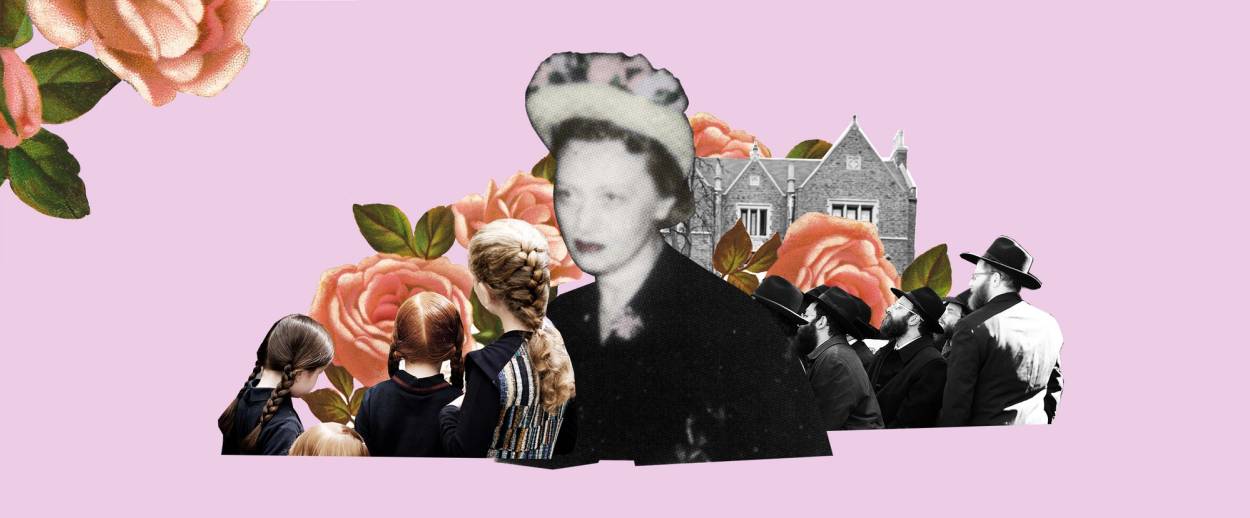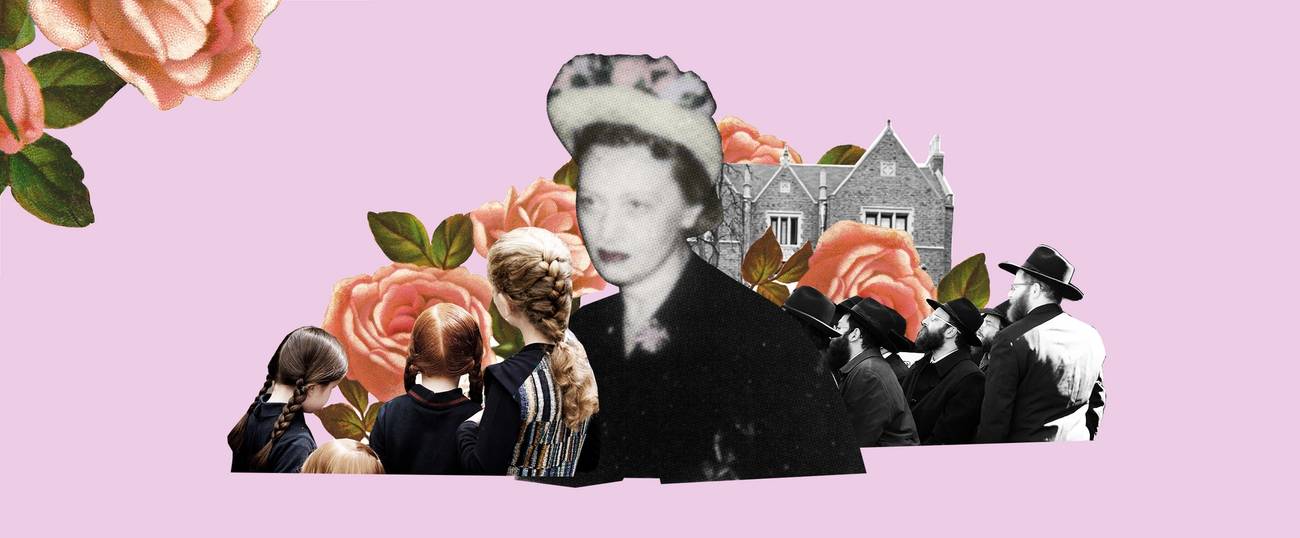Portrait of the Rebbetzin
Chaya Mushka Schneerson kept a low profile as the wife of Chabad-Lubavitch leader Rabbi Menachem Mendel Schneerson. But since her death, 30 years ago today, she has become an iconic figure in her own right.




Attending Bais Rivkah, the flagship Lubavitch girls’ school in Crown Heights, in the 1990s, Sara Blau had about 75 students in her grade named Chaya Mushka, and about as many variations of nicknames: Chaya, Chaya’le, Chaiki, Mushka, Mooka, Mookie, and Musha were some of the more common ones. Teachers called Blau’s cohort the “Chaya Mushka grade” because there were so many students with the name. Born in 1988, they were the first ones to be named after Chaya Mushka Schneerson, the wife of Rabbi Menachem Mendel Schneerson, leader of the Chabad-Lubavitch movement. She died 30 years ago today, on the 22nd of Shevat, 1988.
For young girls—and boys—growing up in the 1990s in the Chabad community, she was an iconic figure, referred to affectionately as Rebbetzin Chaya Mushka, or just “the Rebbetzin” for short. At Bais Rivkah, her picture hung prominently in the school lunchroom/auditorium, right next to the stage. Teachers told stories about her kindness: In one oft-repeated tale, the Rebbetzin once drove past a family being evicted for unpaid rent and gave the marshal a personal check to cover their back rent and stop the eviction. Above all, young girls were taught, the Rebbetzin was gracious and modest. Little girls sang a song at circle time and at school performances that went, in part: “I’m a tznius’dike maidele [modest girl] as you can see/I cover my elbows, I cover my knees/Like Rebbetzin Chaya Mushka I want to be…”
Chaya Mushka Schneersohn (her father’s family spelled the family name with an “h”) was born in 1901, the second of three girls, in Babinovitch, Belarus, close to the town of Lubavitch, to a prominent Hasidic family. She was the granddaughter, daughter, and wife of Hasidic masters. After her birth, her grandfather Rabbi Shalom Dovber, the fifth Lubavitcher rebbe, telegraphed her parents, Rabbi Yosef Yitschak and Nechama Dina, suggesting that she be named Chaya Mushka after her great-great-grandmother, the wife of the Tzemach Tzedek, the third Lubavitcher rebbe.
As a young woman, she was intimately involved in Chabad’s clandestine activities. During the interwar years, as the repressive Communist regime took hold, her family moved to Rostov, where she smuggled supplies to the underground yeshiva, and then again to Leningrad in search of safety. In 1924, when she was 23 years old, her father, who had by then succeeded her grandfather as leader of the movement, granted her power of attorney over private and communal financial matters. A few years later, in 1927, when Rabbi Yosef Yitschak was arrested and briefly exiled by the NKVD for counterrevolutionary religious activity, she accompanied him into exile.
Chaya Mushka married her distant cousin, Menachem Mendel Schneerson, in 1928. The wedding took place in Warsaw and drew thousands of Hasidim from all over Poland, Lithuania, and Russia. They had been engaged for a while but the wedding was delayed because of her father’s arrest and imprisonment. Soon after, the newlyweds moved to Berlin for their university studies. In 1933 they had to flee again, this time to Paris, and they eventually sailed to the United States in 1941 on the last passenger ship to cross the Atlantic. Chaya Mushka’s youngest sister, Sheina, and her husband, Menachem Mendel Horenstein, were still trapped in Poland; they were later murdered in Treblinka.
Chaya Mushka’s father, Rabbi Yosef Yitschak, passed away in 1950, and the story is told that she persuaded her reluctant husband to assume leadership of the Chabad movement one year later. During her lifetime and for most of her husband’s tenure as leader of Chabad, most people in the community did not know her. She kept a low profile. When she called local shops to place an order, she identified herself simply as “Mrs. Schneerson from President Street.” Years ago, a Chabad shlucha who had been in high school when the Rebbetzin died, admitted to me that she did not even know her first name, nor did she expect that a school field trip would be canceled for her funeral.
Baila Olidort, editor-in-chief of Lubavitch International, published by Chabad Headquarters, told me, “The fact is that the Rebbetzin lived a very private life, and consequently she was not well known, or widely known. She didn’t engage with the community or participate in public events. It’s not that we didn’t have an awareness of her presence — we did — but it was an invisible presence. During her lifetime, you didn’t really see her or photos of her. There was always a great curiosity about her. Who was this woman behind the scenes with whom the Rebbe shared his life for so many years? But in her lifetime nobody would dare to try to trespass.”
On the first day of shiva for Chaya Mushka, Rabbi Schneerson prayed mincha—the afternoon service— at their home on President Street and then spoke to the Hasidim who were there. “The living should take to heart,” he exhorted, quoting the prophet in Ecclesiastes. Learning from the life and the values of the person who passed away allows their legacy to become eternal, he explained.
Olidort points to this talk by Rabbi Schneerson as the moment Chaya Mushka began to transform from an almost hidden figure to a community icon: “After she passed away, the Rebbe spoke publicly about her, and I understand that the women asked the Rebbe permission to use her photo. He agreed. Her photo began to adorn homes and schools; the community could now ‘appropriate’ this very private individual as a role model. People wanted to learn more about her, and she took on a public persona.”
***
Much of what is known about how Chaya Mushka Schneerson lived her life comes from stories told by her few confidantes and from people who worked in her household, some of whom participated in a 2008 documentary produced by JEM, Chabad’s media arm, called The Rebbetzin. The narrator in the documentary notes, “Those who knew her are still wary about breaching her privacy. Many interviewees would not share experiences they considered too personal.”
The smallest anecdotes about her life are shared as sort of homilies. Many of those who knew her describe her bearing with words like regal and aristocratic and talk about her gracious hospitality. However, she did not talk much about herself, and ultimately any attempt to understand her life is framed by her extreme reticence. Lubavitchers, and particularly Lubavitcher women, find meaning in her legacy in precisely that quality.
Shaindy Jacobson, the director of the Rosh Chodesh Society at the Rohr Jewish Learning Institute, produces educational curriculum and programming for women directors of Chabad Houses all over the world and mentors them to be teachers in their communities. She sees the Rebbetzin as embodying dignity. “I think that she stood for something that was what, really in an upright society, what every Jewish woman stands for, which is something that we could call kol kevudah bas melech penimah [“The glory of the daughter of the king is within,” Psalm 45:14], which is something that every Jewish woman should aspire to. It means that a Jewish woman has dignity, and has personal space, and has her priorities straight, and some things are not for the public and some things are for the public. And how does it manifest? I think if you look at all the Chabad women out there in the world who have given themselves over to the mission, and they certainly aren’t hiding in the kitchen and they’re certainly not hidden figures but I don’t believe they are looking per se to be public figures. I think they’re looking to do the right thing in the right way. And I think that’s really the dignity of a Jewish woman. And I think that’s what the Rebbetzin was.”
A generation of Lubavitch girls was raised with this lesson of modesty and dignity while also being educated to become future directors of Chabad Houses all around the world. While Jacobson does not see these roles as incongruent, others have grappled with what they felt was an inherent tension, including Sara Blau, who is now extracurricular director of Bais Rivkah High School, her alma mater. “On the one hand,” Blau mused, “she was so modest, it seems like a contradiction that the Rebbe said, get out there.” But she also repeated Jacobson’s message of dignity, even using the same word: “It took a maturity to understand that it’s really not a contradiction. Modesty is not a contradiction to shlichus. The world today is all about marketing, it’s all about branding. This was a woman who could have gotten all the attention. And she didn’t want it. She shunned it. I believe we should get there out without needing the external attention that people give. Being sure enough in my sense of self, in my conviction, in who I am, that I don’t need the validation. I’m talking about dignity—an inner core that’s not defined by externalities.”
There is a certain irony that in her death, Chaya Mushka Schneerson became the sort of iconic figure she tried to prevent her entire life. But it is precisely that reticence that has come to define her.
***
Like this article? Sign up for our Daily Digest to get Tablet Magazine’s new content in your inbox each morning.
Miriam Levy-Haim is a student at the CUNY Graduate Center’s Master’s program in Middle Eastern Studies, with a particular interest in the history of Jews of the Middle East. She has worked for several Jewish educational institutions developing curricula for adults and teens.